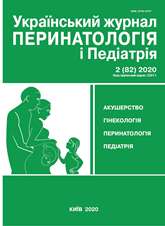Aortic aneurysm of major vessels during pregnancy. Multidisciplinary approach
DOI:
https://doi.org/10.15574/PP.2020.82.27Keywords:
aortopathy, aortic dissection, pregnancy, aortic aneurysm, type А aortic dissection, thoracic aortic aneurysmAbstract
Purpose — to develop an algorithm of obstetric and cardiac surgical tactics in women of reproductive age with aneurysmal lesions of the major vessels.
Materials and methods. An analysis of the world experience of managing patients with aortopathies combined with pregnancy from English, Ukrainian, Russian literature sources of databases PubMed, Medscape, Google Search, Elsevier for the last 10 years. 19 sources were analyzed, which included review articles, data from cohort studies. The publications with the largest series of analyzed cases were selected for analysis. Review articles were selected with the largest number of analyzed studies. The guidelines of the European Society of Cardiology 2018 (ESC 2018) were taken into account to determine the recommendations. The experience of the multidisciplinary team «Obstetric Cardiology» with this group of pregnant women for 6 years is presented.
Results and conclusions. Marphan syndrome is recognized as a leading risk factor for aortic dissection during pregnancy. The most dangerous are the third trimester of pregnancy and the postpartum period. Preconception counseling of women risk-group is substantial, it is important also for identification of women who are contraindicated in pregnancy without elimination of pathological conditions of the aorta, as well as the development of an individual pregnancy plan by a multidisciplinary team with a proven algorithm for tactical decisions in case of complications. The multidisciplinary team «Obstetric Cardiology» uses recognized global trends in the treatment of women with aortic dissection in the antenatal and postnatal periods with successful results.
The research was carried out in accordance with the principles of the Helsinki Declaration. The study protocol was approved by the Local Ethics Committee of these Institutes. The informed consent of the patient was obtained for conducting the studies.
References
A1. Kim GI. (2018). Sohranenie aortalnogo klapana pri hirurgicheskom lechenii rassloeniya voshodyaschego otdela aortyi: dissertatsiya na soiskanie uchenoy stepeni kandidata meditsinskih nauk. Sankt-Peterburg: 204.
Lazoryshynez VV, Siromakha SO, Rudenko KV, Prokopovych LM, Davydova YuV, Limanska AYu. (2016). Life-threatening conditions in pregnant's with cardiovascular pathology: multidisciplinary approach. Perinatologiya and pediatriya. 1 (65): 18–21. doi 10.15574/PP.2016.65.18
Lazoryshynets VV, Davydova IuV, Limanskaya AIu, Siromakha SO. (2019). Difficult GUCH patient in obstetric practice: multidisciplinary approach to cardio-perinatal management. Perinatologiya and pediatriya. 1 (77): 5—11. https://doi.org/10.15574/PP.2019.77.5
Martyshyn OO. (2017, Sep 15). Materynska smertnist v Ukraini: zaproponovano shliakhy vyrishennia problemy. Ukrainskyi medychnyi chasopys: 1—4.
Siromakha SO, Davydova YuV, Lymanska AIu, Lazoryshynets VV. (2019). Multydystsyplinarnyi suprovid vahitnykh i porodil iz vrodzhenoiu vadoiu sertsia. Visnyk sertsevo-sudynnoi khirurhii. 1: 31—37.
Assad RS. (1992). Extracorporeal circulation in the isolated in situ lamb placenta: hemodynamic characteristics. J Appl Physiol. 72: 2176—2180. https://doi.org/10.1152/jappl.1992.72.6.2176; PMid:1629070
Ch'ng SL. (2013). Stanford Type A Aortic Dissection in Pregnancy: A Diagnostic and Management Challenge. Heart, Lung and Circulation 13; 22: 12—18. https://doi.org/10.1016/j.hlc.2012.08.005; PMid:23084107
Coulon C. (2015, November). Thoracic aortic aneurysms and pregnancy. La Presse Medicale. 44 (11): 1126—1135. https://doi.org/10.1016/j.lpm.2015.02.024; PMid:26454306
ESC. (2018). Guidelines for the management of cardiovascular diseases during pregnancy. European Heart Journal. 39: 3165—3241.
Kamel H. (2016). Pregnancy and the risk of aortic Dissection or rupture. A cohort-crossover analysis. Circulation. 134: 527—533. https://doi.org/10.1161/CIRCULATIONAHA.116.021594; PMid:27492904 PMCid:PMC4987245
Liu Yu-Yong. (2017). Treatment of patients with aortic disease during pregnancy and after delivery. Journal of International Medical Research. 45 (4): 1359—1368. https://doi.org/10.1177/0300060517711088; PMid:28587539 PMCid:PMC5625542
Nienaber CA. (2004). Gender-Related Differences in Acute Aortic Dissection. Circulation. 109: 3014—3021. https://doi.org/10.1161/01.CIR.0000130644.78677.2C; PMid:15197151
Sawlani N, Shroff A, Vidovich MI. (2015). Aortic dissection and mortality associated with pregnancy in the United States. J Am Coll Cardiol. 65: 1600—1601. https://doi.org/10.1016/j.jacc.2014.12.066; PMid:25881947
Silaschi M. (2017). Aortic dissection: medical, interventional and surgical management. Heart. 103; 1: 78—87. https://doi.org/10.1136/heartjnl-2015-308284; PMid:27733536
Tara O`Neill Hayes (2019, September 9). Maternal Mortality in The United States. American action forum.
Thalmann M. (2011). Acute type A aortic dissection and pregnancy: a population-based study. European Journal of Cardio-thoracic Surgery. 39: e159—e163. https://doi.org/10.1016/j.ejcts.2010.12.070; PMid:21353789
Wanga S, Silversides C. (2015). Pregnancy and Thoracic aortic disease: managing the risks. Canadian Journal of Cardiology: 1—8. https://doi.org/10.1016/j.cjca.2015.09.003; PMid:26604124
Yuan SM. (2013). Aortic dissection during pregnancy: a difficult clinical scenario. Clin Cardiol. 36: 576—584. https://doi.org/10.1002/clc.22165; PMid:23843107 PMCid:PMC6649420
Zhu Jun-Ming. (2017). Aortic dissection in Pregnancy: Management, strategy and outcomes. ANN Thorac Surg. 103: 1199—1206. https://doi.org/10.1016/j.athoracsur.2016.08.089; PMid:27825688
Downloads
Published
Issue
Section
License
The policy of the Journal “Ukrainian Journal of Perinatology and Pediatrics” is compatible with the vast majority of funders' of open access and self-archiving policies. The journal provides immediate open access route being convinced that everyone – not only scientists - can benefit from research results, and publishes articles exclusively under open access distribution, with a Creative Commons Attribution-Noncommercial 4.0 international license(СС BY-NC).
Authors transfer the copyright to the Journal “MODERN PEDIATRICS. UKRAINE” when the manuscript is accepted for publication. Authors declare that this manuscript has not been published nor is under simultaneous consideration for publication elsewhere. After publication, the articles become freely available on-line to the public.
Readers have the right to use, distribute, and reproduce articles in any medium, provided the articles and the journal are properly cited.
The use of published materials for commercial purposes is strongly prohibited.

